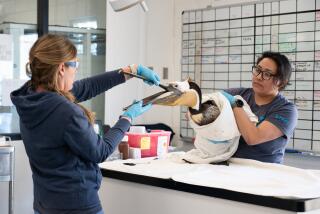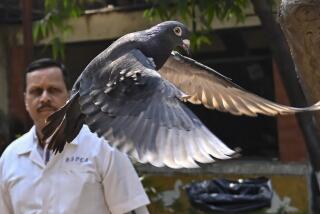A Sanctuary for Ailing Birds in Delhi
NEW DELHI — In the honking chaos of Delhi’s Old City, surrounded by bustling streets and crowded alleys teeming with pedestrians, hand-pulled carts and motorized rickshaws, sits a haven where sparrows chirp, pigeons coo and peacocks shriek.
For bird lovers across northern India, the terra-cotta colored Charity Bird Hospital in the yard of the 16th century Digamber Jain temple here has become a sanctuary for ailing birds and small animals.
Anyone who finds an injured bird can bring it to the hospital, where it will be nursed back to health. All treatment, including surgery, provided by a team of veterinarians and volunteers is free.
And once the birds recover, they are set free, Vijay Kumar, a veterinary surgeon at the hospital, said.
There’s also a free phone-in service that dispenses advice to owners of ailing birds.
At any given time about 2,500 birds are being treated at the hospital, Kumar said.
“The fall and winter months are the worst time as it’s the kite-flying season in New Delhi. Each day we get scores of birds, mostly pigeons, whose limbs have been cut by kite strings in which the birds get entangled,” Kumar said.
Sitting in his tiny office, its walls decorated with traditional Mogul paintings of different species of birds and hunting scenes, Kumar doubles as the hospital’s accountant, writing out receipts when people drop off a donation.
“My daughter’s just cleared her medical college examinations. Whenever something good happens we make a donation to the hospital,” Srimali Jain said as she collected a handwritten receipt for her donation of 1,000 rupees, about $22.
Founded in 1929, the hospital runs on thousands of such donations, mostly from followers of Jainism, a religion that emphasizes nonviolence and calls for a deeply spiritual deference to all living beings.
“But we get donations from all sorts of people -- Hindus, Muslims, Christians. It’s a humanitarian cause,” Kumar said.
Bird injuries occur year round. In summer, birds collapse in northern India’s searing heat, and many fly into electric poles or vehicles. In winter, dense smog leads to birds’ injuries.
The birds are treated and placed in individual cages. When they get a little better, they are moved into a larger cage with other convalescing birds.
“We found this one early this morning,” Kumar said as he gently wrapped a cotton bandage over a tiny plaster cast on a pigeon’s leg. “Its leg was broken and entangled in kite string, but we’ve set the bone and it will heal.”
Once the bird is healed, it will be moved to a general ward, said Vinod Singh, a hospital volunteer. “We will observe its flying ability and assess whether it can forage for food.”
Each morning, Singh braves the sharp stench of bird droppings to see how the birds are faring and whether any need more treatment.
Since the hospital is guided by the Jain philosophy of not harming even the smallest living creature, the birds, even carnivores, are fed a vegetarian diet of green vegetables, nuts, grains and cereals.
The only hesitation that owners have in bringing their pets to the hospital is that, once cured, the birds are not returned to them, but are set free.
Smaller birds such as finches, sparrows, pigeons and parrots are released from the roof of the hospital. Larger birds such as peacocks and eagles are released in forests along the nearby River Yamuna.
“The happiness you get when you set free a healthy bird, cured of all its pain, cannot be described. It has to be experienced,” Singh said.
More to Read
Sign up for Essential California
The most important California stories and recommendations in your inbox every morning.
You may occasionally receive promotional content from the Los Angeles Times.










